|

Felines - small, wild beautiful III:
The hardy sand cat and agile margay
Have you been
enjoying reading about the different members of the feline family we
featured the last couple of weeks? The little wild cats are indeed
fascinating and cute too. Perhaps some of you are dreaming of owning one
as a pet.
As most wild cats are similar to their big cousins, especially the
leopards, having a small wild cat would be like having a leopard cub
that never grows big. But, even though some small wild cats are kept as
exotic pets, they should really be allowed to live where they belong -
in the wild!
Today too we introduce you to yet another pair of feline beauties
from Asian and African deserts and the American continent. They are the
sand cat and the margay.
Sand cat
|
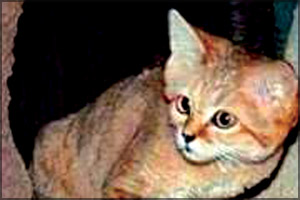
It stays in a den most of the time. |
|
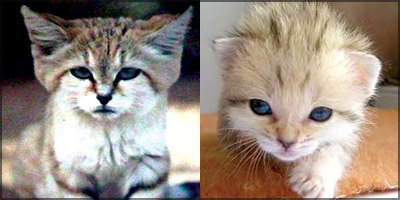
It has a broad face
Kittens are born blind.
and pointed ears. |
|

Sand cats freeze on the spot when disturbed. |
It is considered to be the most attractive feline in Arabia. The Sand
cat (Felis marganta) lives in the African and Asian deserts such as the
Sahara, Arabian desert, and deserts in Iran and Pakistan. It can live in
areas that are too hot even for the desert cat.
It can survive in temperatures ranging from -5 to +52 degrees
Celsius. Six sub-species have been recognised so far. The sand cats
indigenous to each area are classified as sub-species.
The sand cat, as its name implies, prefers sand dunes, but is found
in rocky areas too, especially as it hides under rocks during the
daytime. It is solitary and predominantly nocturnal. It hunts only at
night, returning to its den before sunrise to shelter from the harsh
desert sun and predators.
The sand cat's diet consists of small rodents, reptiles including
venomous desert snakes, insects and small birds. It hardly needs water
since it obtains most of its requirements from its prey. As a result, it
stays away from water points.
It is about 50 cm (20 inches) in length with a tail of 30 cm (12
inch). It's 30 cm in height at the shoulders. The sand cat weighs about
2.7 kg (6 lbs) and is slightly smaller than the average domestic cat. It
has short legs, forward placed eyes, a broad head and large, pointed
ears.
The ears set wide apart are disproportionately large, but gives it
acute hearing. The colour of the coat is uniformly grey, sandy brown or
golden yellow and is finely speckled with black above the shoulders. Its
coat colour provides ideal camouflage in the desert.
There are fairly distinct black barring on the thighs. The fur on top
of the tail is black. The broad face is marked with a pronounced reddish
strip which extends from each eye backwards across the cheek. The chin,
throat, chest and belly areas are covered with thick, soft, white fur.
There are two elaborate bars on the limbs.
The sand cat's paws are different to that of most wild cats. The
palms and soles are covered by a dense mat of fine black hairs to
protect the sensitive pads from the hot sand and also to prevent sinking
in the soft sand.
|

It has large eyes |
|
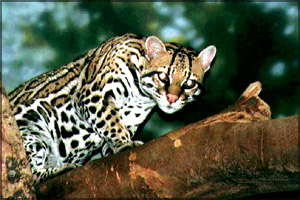
A skilful climber |
The large ears which can swivel (turn) to funnel sound into the inner
ear too are protected from the sand by coarse hairs.
The sand cat is well insulated by its thick fur. The sand cat, which
is also one of the smallest cats in the feline family and in Arabia, is
similar to Gorden's wildcat, but is much paler in colour. It usually
stays in a den which is dug by itself, when not hunting.
This den is used the whole year through. The female gives birth to a
litter of 1-8 kittens (typically 4-5) after a gestation period of 62
days. The kittens develop rapidly and become independent at an early age
in the wild.
They are born blind and open their eyes only after two weeks. At
birth, the kittens weigh around 40 grams. Their daily weight gain is 12
grams. They have distinctive markings on the coat, but they fade away as
the kittens grow.
The first four kittens bred in captivity were recorded from the Al
Ain Zoo in UAE in 2000. In captivity, sand cats live up to 13 years.
Sand cats have extremely sharp teeth and claws. The impression of the
claws is often visible in the tracks.
When disturbed, sand cats normally freeze, wherever they are. They
also have a tendency to close their eyes against the lights at night. As
they are not easy to spot in the wild, they are considered to be rare.
However there are some who bring up sand cats as pets.
***
Margay
|
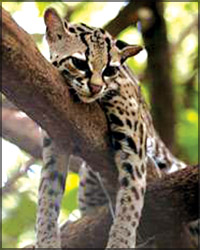
Lives mostly on trees. |
|
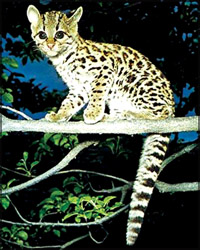
Its plush tail is used to maintain balance |
Native to Central and South America, the Margay (Leopardus wiedi),
also known as the long tailed spotted cat, is similar to the Ocelot
(featured in the Junior Observer of January 13) in appearance. It is
also a solitary and nocturnal animal like most of the other cats we've
featured so far.
The margay prefers to live in remote rainforests and its range
extends from Mexico, down through Peru to parts of Paraguay to the
northern areas of Argentina.
It is about 3-9 kg (6.6 - 20 lbs) in weight and has a body length of
45-80 cm with a tail of about 33-51 cm (13-20 in). In comparison to its
body, its tail and legs are longer than in other cats. It's plush, thick
tail, which averages 70 per cent of its head and body length, is used as
a counterweight to aid in balance.
Even though the margay is often mistaken for the ocelot, there are
marked differences especially in the coat markings. For instance, the
rossett markings on a tawny to yellow/buff background are less defined
in the margay than in the ocelot, and appears more frequently as
blotches along its back. The cat has extensively large eyes which aid in
its night vision.
The margay is a skilful climber and is often referred to as the 'Tree
Ocelot'. The Margay is physically adapted to life in trees and may spend
its entire life pursuing prey on trees. It is one of two species which
has the ability to rotate its hind feet.
|
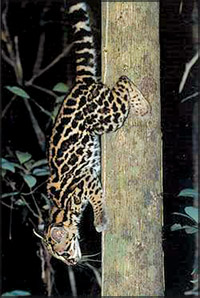
It can come down trees, head first. |
The other small, wild cat which can do this is the clouded leopard.
Because of the flexibility of the ankles which can turn up to 180
degrees, the margay can come down trees, head first.It can also grasp
the branches of trees firmly with its fore and hind paws and hang on one
foot from trees. It can also jump considerable distances.
The margay's diet consists of birds, lizards, tree frogs, big-eared
climbing rats, eggs and even porcupines. It has been found that the
margay may eat grass and vegetation to help in digestion, like domestic
cats do. It hunts almost exclusively at night most of the creatures that
inhabit the forest canopy and hunt creatures on the ground and eat
fruits as a supplementary diet.
Of all the felines, the margay is the most adaptable to true arboreal
life.
The female gives birth to only one kitten most often and it weighs
around 2.75 - 6 ounces. Like most cats, the Margay kitten also opens its
eyes when it's around two weeks old. It's weaned after two months.
In captivity, margays have lived up to 20 years! |
